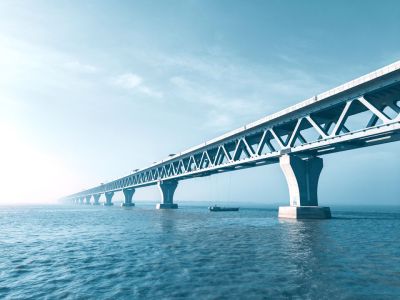Padma Bridge
Padma Bridge a multi-purpose road and railway bridge under construction on the padma river in Bangladesh. The bridge area falls in three districts- Munshiganj (Mawa Point/North bank), Shariatpur and Madaripur (Jajira/South bank) and connects the south-western part of the country with the north-eastern part. For a developing country like Bangladesh, the Padma Bridge is a milestone for economic and regional development. This had been one of the biggest challenging construction projects in the history of the country's infrastructure development sector. The two-sided steel and concrete bridge known as Truss bridgehas a four-lane road over the top and a single railway track below. With a length of 6.150 km and a width of 18.10 m or 62 feet, the Padma Bridge is the largest in Asia and the 25th in the world.

The design of this multi-faceted socio-economic development project was made by a team of international and national consultants led by AECOM, a reputed design company specializing similar type of bridges. On August 28, 2007, the former caretaker government passed the plan of the main project at the cost and approved the plan of constriction of the Tk 10,161 crore. According to the project document, the construction of the bridge was supposed to start in 2011 and end in 2013.Later, the Awami League government revised the plan and added the railways component and on 11January 2011,approved the increase in the cost of the bridge in the first phase. At that time the cost was estimated at Tk 20,502 crore. The project is being funded from the own resources of the Government of Bangladesh. The cost estimate of the Padma Bridge has been increased further to Tk 30,193 crore in two more phases. The new time to complete the bridge was set as June 2022 and the time overrun was due to the Covid 19 pandemic.
The total land acquired for the Padma Bridge is 917 hectares. The physical work of the bridge has been divided into five packages, namely (i) Main Road, (ii) Rail Bridge, (iii) River regimen, (iv) Jazira Approach Road, (v) Toll Plaza and Mawa and Jajira Service Area. River regimen is one of the major challenges in the construction of the Padma Bridge. At first it was necessary to find the hard soil at the bottom of the river Padma.The real extent of problem was discovered in the piling work of the bridge and the difficulty was largely because of lack of normal soil below the waters. Later, an attempt was made to build a layer of new soil at the bottom of the river by artificial replacement. The method is called screen grouting. The viaduct of the bridge is 3.17 km, the total viaduct is 61 pillars; the height of the Padma Bridge is 60 feet from the water level, the piling depth is 363 feet and the total number of pilings is 264. The road connecting the bridge has a total length of 14 km on both sides, and the river has already ruled 12 km on both sides.
The Padma Multipurpose Bridge connects the southwestern part of Bangladesh with the center of the country through Mawa Jajira Point. This bridge is expected to significantly contribute to the social, economic and industrial development of Bangladesh and specially the relatively underdeveloped region of it. The project will directly benefit more than 30 million people in an area of about 44,000 sq km (16,000 sq mi) or 29% of the total area of Bangladesh.The Padma Bridge is a very important infrastructure for the country's transport network and regional economic development. The bridge has rail, gas, power lines and fiber optic cable expansion facilities.It is expected that this bridge will increase the country's GDP by 1.2 percent. [Muhammad Abdul Mazid]
